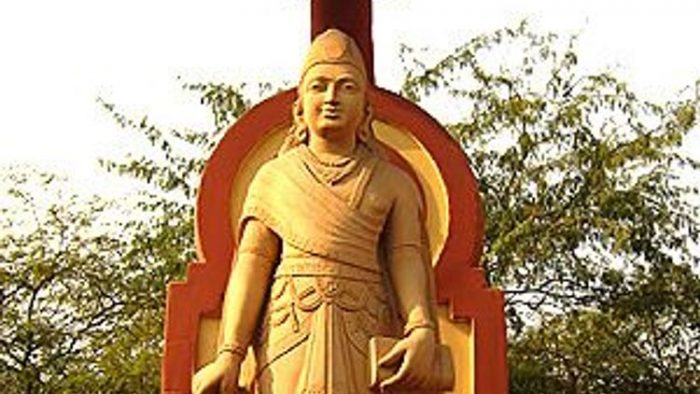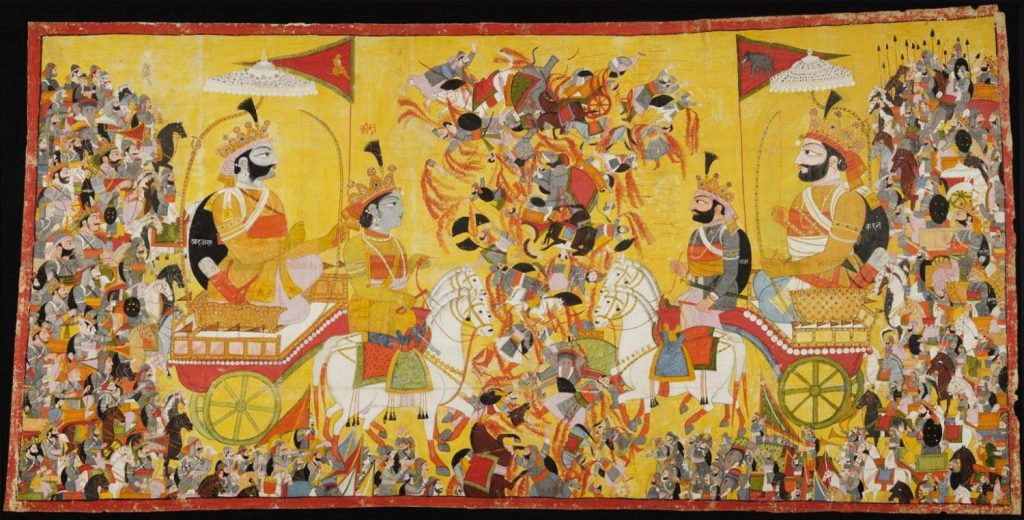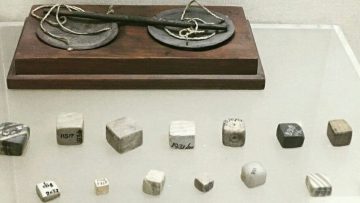Who was Sandrakottos?
The Greek Historian Strabo has recorded that Megasthenes was sent to Pātaliputra as an ambassador to ‘Sandrakottos’, and Deimachus as an ambassador to his son, ‘Amitrachades’ [ref: 1, p18,19]. In 1793 CE, Sir William Jones, the founder of the Royal Asiatic Society presented to the Asiatic Society his “discovery” that ‘Sandrakottos’ was the Indian king “Chandragupta Maurya”. This “discovery” by him was readily accepted by the modern historians, although there is very little resemblance between the names ‘Sandrakottos’ and ‘Chandragupta’, and ‘Kottos’ especially has no resemblance to ‘Gupta’. Moreover, the name of Chandragupta Maurya’s son could not even be remotely related to ‘Amitrachades’ as recorded by the Greek historians. It may be mentioned that to “overcome” this discrepancy, the modern historians have introduced in the history books, that Chandragupta Maurya’s son, Bindusāra, used the title “Amitraghāta”. There is no inscriptional or literary evidence to this effect [Ref: 2]. Anyway, “Amitraghāta” means “Slaughter of enemies”, not “Slayer of enemies”, and thus, it cannot be the title of a person as claimed by modern historians. Also, the period of Alexander and Seleucus does not even remotely match the period of Chandragupta Maurya, as per the chronology of kings given in the Bhāgavata Purāna. Then, who was Sandrakottos?
In Greek mythology, ‘Kottos’ was a giant with 50 heads (100 ears) and 100 hands. Several kings of the Andhra (Shatavāhanas) dynasty which ruled over India, with their Capital at Pataliputra, for 456 years, [Ref. Bhāgavata Purāna Skandh 12, Chapter 1] before the Gupta dynasty used to write ‘Shatakarni’ as a surname. Shatakarni literally means “a person having a hundred ears”. The Greek Historians identified the surname ‘Shatakarni’ with the Greek ‘Kottos’, who also had a hundred ears. Thus, ‘Kottos’ is a Greek equivalent for the Indian ‘Shatakarni’. One of these Andhra dynasty kings who wrote ‘Shatakarni’ with his name was ‘Sundara’ [Ref: Brahmanda Purāna & Vishnu Purāna]. ‘Sundara’ very much resembles ‘Sandra’. It indicates that ‘Sandrakottos’ of the Greek historians was king ‘Sundara Shatakarni’ of the Andhra dynasty. In Bhāgavata Purāna, his name has been mentioned as Sunandana. It may be noted that in Sanskrit, ‘Sunandana’ is a synonym of ‘Sundara’. Another synonym of ‘Sundara’ is Priyadarshi. In the classical Hindi and Sanskrit literature, and perhaps in Greek literature too, it was a common practice to substitute the names of persons and cities with their synonyms. After ’Sunandana’ it is written in the Bhāgavata Purāna.
चकोरा बहवो यत्र शिवस्वातिररिन्दमः [Bhāgavata Purāna, Skandha 12, Chapter 1]
which literally means, Shivasvāti Arindama was where Greek partridges (Chukar partridges) were abundant. It may be noted that in Bhāgavata Purāna, the word ‘चकोरा’ has been misprinted as ‘चकोरो’, which is not correct, because, with the adjective ‘बहवो यत्र’, which is in the plural, the noun should also be plural, whereas ‘चकोरो’ is singular. So, it must be read as ‘चकोरा’, otherwise the whole clause would become meaningless. Due to this misprint, ‘चकोर’ has been misinterpreted by some as the name of a king.
As Chukar partridges are abundant in the region ranging from North East Greece to northwest India, [Ref: 3] the statement indicates that Sunandana’s (Sundara’s) brave son, Shivasvāti, nicknamed ‘Arindama’ meaning “Thrasher of the enemies”, was deputed as a ‘Satrap’ in the North West region of the Indian kingdom (because that region of the kingdom was prone to invasion by the Greeks). It may be noted that since ‘Arindama’ is a synonym of ‘Amitrachhid’ in Sanskrit, both meaning ‘Thrasher of the enemies’, he was also nicknamed as ‘Amitrachhid’, which has been recorded as ‘Amitrachades’ by the Greek historians. Thus, the identification of the father-son due to viz. ‘Sandrakottos’ and ‘Amitrachades’, with ‘Sundara Shatakarni’ and ‘Arindama’ is complete.
To establish this identification further, let us look into the time-periods of Megasthenes and Sundara Shatakarni. As per Greek history, Alexander invaded India in 326 BCE. After his death in 323 BCE, his empire was divided into several parts, ruled over by different kings. The Eastern part close to the Indian kingdom was ruled by Seleucus. Subsequently, Seleucus entered into a treaty with the Indian king in 302 BCE in which he gave his daughter, in marriage, to the Indian king along with a large part of his kingdom, and in return, got 500 elephants from the Indian king who had 9,000 elephants.
Seleucus sent Megasthenes as an ambassador to the Indian king at Pataliputra. The Western historian C. Miller writes that “The time when he discharged his embassy or embassies and how long he stayed in India cannot be determined, but he was probably sent after the treaty had been struck and friendship had sprung up between the two kings. If therefore, we make the reign of Sandrakottos extend to the year 288 BCE, Megasthenes would have set out for Pataliputra between 302 BCE and 288 BCE.” [Ref: 1, p14]
As per the chronology of dynasties of Indian kings after the Mahābhārata War given in Bhāgavata Purāna, the Andhra dynasty ruled over India for 456 years, from 610 BCE to 154 BCE (for detailed calculations, see 2.0 and 3,0 below). The separate period of the reign of each king has not been given in Bhāgavata Purāna, but in Matysa Purāna, the separate periods of reign of these kings have been mentioned. From this, the year of the start of Sundara’s reign works out as 292 BCE (see 3.0 below), which tallies very well with the period mentioned by C. Miller, the Western historian.
The above analysis very clearly establishes that ‘Sandrakottos’ of the Greek historians was none else but Sundara Shatakarni of the Andhra dynasty, as all the facts, viz. His name, his son’s name, and the period of his reign tally exactly with those given by Greek historians and Miller. It may be noted that Max Muller pointed out, on the basis of the records of the ancient Greek writers that “Sandrakottos” established his new kingdom only after the invasion by Alexander [Ref: 4]. That means ‘Sandrakottos’ was not the Indian king when Alexander invaded India in 326 BCE.
Some Indian researchers have identified ‘Sandrakottos’ with the Gupta king ‘Chandragupta I’ [Ref: 2] or Samudragupta [Ref: 7] which is not correct, because the reign of the Gupta dynasty started much later than the period of Megasthenes. If the period of Chandragupta I or Samudragupta is pre-dated to match with that of Megasthenes, then who started the Vikrami Samvat in 58 BCE? Thus, the identification of ‘Sandrakottos’ with Chandragupta I or Samudragupta is a well-intentioned attempt, but cannot be accepted as correct due to this chronological problem. Further, their names do not have much resemblance to ‘Sandrakottos’, and ‘Kottos’ in particular has no resemblance to ‘Gupta’.
Year of the Mahābhārata War
The following three independent sources establish the year of the Mahābhārata War –
1) The Aihole Inscription:
The Famous Aihole Inscription, established in the 7th century CE by king Pulikeshi II of the Chalukya dynasty reads :
त्रिंशत्सु त्रिसहस्रेषु भारतादाहवादितः।
सप्ताब्दशतयुक्तेषु गतेष्वब्दषु पंचसु ॥
पंचाशत्सु कलौ काले षट्सु पंच शतेषु च ।
समासु समतीतासु शकानामपि भूभुजाम् ॥
meaning: “To date 3735 years have elapsed since the Mahābhārata War, and 556 years have elapsed since the start of Shaka kings’ rule in Kaliyuga.”
From this, it is evident that the Mahābhārata War took place (3735 – 556) = 3179 years before the ‘Shaka’ Samvat which started in 78 CE, giving the year of Mahābhārata as 3102 BCE.
2) Internal Evidence in the Mahābhārata Itself:
A shloka in the Mahābhārata reads:
प्रयाते तु ततः कर्णे योधेषु मुदितेषु च ।
निःसरंतो व्यदृश्यन्त सूर्यात् सप्त महा ग्रहाः ॥ [Parva 8, Chapter 37]
meaning, “When Karna, along with joyful warriors, marched (for the war), seven major planets appeared to be coming out from the Sun.”
This shloka refers to the time when Karna was the Commander-in-Chief of the Kaurava army on the 17th day of the war. It is clear from this verse that 7 planets were in near alignment with the Sun at that time.
According to the famous book on Astronomy “Sūrya Siddhanta”, this rare event occurs at the start of Treta yuga or at the start of Kaliyuga. It indicates that Kaliyuga started on the 17th day of the Mahābhārata War, thus establishing that the Mahābhārata War took place at the start of Kaliyuga, i.e., in 3102 BCE, as Kaliyuga started in 3102 BCE [Ref: 8, 9]
3) Aine-Akbari (आईने अकबरी):
In “Aine-Akbari”, the famous treatise on Indian History, it is written by the Prime Minister of King Akbar that “At the very start of Kaliyuga, the first king was Yudhishthira. Before the start of Vikrami Samvat, 3044 years of Yudhisthira era had elapsed.” [Aine Akbari, published in 1867 CE, p269]. Thus, Yudhishthira’s Coronation, at the end of the Mahābhārata War took place in (58+3044) = 3102 BCE, and also that Kaliyuga started in 3102 BCE.
From this, it is established, beyond doubt, on the basis of three independent sources, that the Mahābhārata War took place in 3102 BCE, and that Kaliyuga also started in 3102 BCE.
Dating of Post-Mahābhārata History:
In Bhāgavata Purāna [Skandha 12, Chapter 2, Shloka 1], it is written that 1510 years had elapsed from the birth of Parikshit up to the coronation of Nanda. As Parikshit was born a few months after the Mahābhārata War, in 3102 BCE, the year of the coronation of Nanda works out to be (3102-1510) = 1592 BCE.
The period 1510 has been wrongly interpreted by some people as 1115 years because the printed wording is “एतद् वर्ष सहस्रं तु शतं पंच दशोत्तरं” instead of “एतद् वर्ष सहस्रं तुशत पंच दशोत्तरं”. In this context, it may be observed that in Bhāgavata Purāna itself, it is mentioned that after Sahdeva, the son of Jarāsandha, who was installed as the king a few years before the Mahābhārata War, his descendants ruled for a thousand years [Ref: Skandha 9, Chapter 22, shlokas 46 to 49], and after that, 5 Pradyotans ruled for 138 years and 10 Shishunagas ruled for 360 years [Ref: Skandha 12, Chapter 1, shlokas 2 to 8], adding up to (1000+138+360) = 1498 years. It may be that the period of a “thousand years” may be a rounded-off figure for 1012 years. Thus, the correct version is 1510 years and not 1115 years.
After Nanda’s coronation, he and his eight sons ruled for a hundred years [Ref: Bhāgavata Purāna, Skandha 12, Chapter 1, shlokas 9 to 11], and then Chandragupta Maurya was installed as the king [Ref: Bhāgavata Purāna, Skandha 12, Chapter 1, shlokas 12, 13]. Thus, the year of the coronation of Chandragupta Maurya works out to be (1592-100) = 1492 BCE.
The names of contemporary kings found on Ashokan inscriptions are Amtiyoka, Tulamaya, etc. Amtiyoka ruled Afghanistan at around 1475 BCE, which then appears to be the approximate date of Ashoka’s – the grandson of Chandragupta Maurya’s – rule [Ref: 10].
According to Vedveer Arya, Chandragupta Maurya ascended the throne in 1534 BCE [Ref: 7].
According to Swami Prakashananda Sarasvati, Chandragupta Maurya ascended the throne in 1541 BCE [Ref: 11].
The main discrepancy in their calculations has crept in due to misinterpretation of the following shlokas in Bhāgavata Purāna (skandha 12, chapter 3):
विष्णोर्भगवतो भानुः कृष्णाख्योऽसौ दिवं गतः ।
तदाविशत् कलिर्लोकं पापे यद् रमते जनः ॥ २९ ॥
यावत् स पादपद्माभ्यां स्पृशन्नास्ते रमापतिः ।
तावत् कलिर्वै पृथिवीं पराक्रान्तुं न चाशकत् ॥ ३० ॥
यस्मिन् कृष्णो दिवं यातः तस्मिन् एव तदाहनि ।
प्रतिपन्नं कलियुगं इति प्राहुः पुराविदः ॥ ३३ ॥
meaning, “When That Lord Vishnu’s Light named Krishna left for Heaven, then Kali entered the world so that people’s minds take pleasure in sinful activities. So long as Lord Krishna kept touching the Earth with his lotus feet, till then, Kali could not exert its power on the Earth. The day Lord Krishna left for heaven, on that very day, Kaliyuga started to act – so say the Historians.” The connotation of these shlokas is very clear. It means that Kaliyuga (although it had started earlier) could not exert its power on the minds of the people until Lord Krishna left for heaven. Many Historians have interpreted these shlokas to mean that Kaliyuga started on the day Lord Krishna left for heaven. This misinterpretation pushes back the year of Mahābharata and other events of history by 36 years.
The dating of Chandragupta Maurya by the Western Historians as about 320 BCE is off by about 1170 years. As the Western Historians have taken the year of Chandragupta Maurya’s coronation as the anchor sheet of Indian History, the whole History of India has been grossly distorted.
After that, the periods of reign of the following dynasties have been recorded in the Bhāgavata Purāna, Skandha 12, Chapter 1, shlokas 13 to 28.
- Maurya 337 years
- Shunga 200 years
- Kanvayan 345 years
- Andhra 456 year
Thus, the year of the start of the Andhra dynasty rule works out to be (1492-337-200-345) = 610 BCE.
It may be observed here that in the Bhāgavata Purāna, the years of the reign of the Maurya dynasty has been misprinted as 137 years instead of 337 years. The number of kings of the Maurya dynasty has been mentioned as 10. In the Matsya Purāna, the total years of the reign of 6 Maurya kings are given as 199 years. In view of that, 137 years is clearly a misprint. The misprinted word is “सप्तत्रिंशच्छतोत्तरं” meaning 137, instead of “सप्तत्रिंशच्छतत्रयं” meaning 337. It may be noted that both these words have the same number of syllables and sound alike.
Similarly, the number of years of the reign of the Shunga dynasty kings has been misprinted as “वर्षशताधिकं” which means “more than a hundred years”. (How many more than a hundred?) Thus, this word does not convey any specific sense. The nearest sounding word with the same number of syllables is “वर्षशतद्वयं”, meaning 200 years.
The total number of years of the reign of the Andhra dynasty kings, as per Matsya Purāna, up to the start of Sundara’s reign, adds up to 318 years. Thus, the year of Sundara’s coronation works out to be (610-318) = 292 BCE, which tallies very well with the period (given by Western Historian, C. Miller) when Megasthenes was sent as an ambassador to the Indian king sometime between 302 BCE and 288 BCE.
Thus, the identity of “Sandrakottos” as “Sundara Shatakarni” is completely established.
As per the Bhāgavata Purāna, after the Andhra dynasty, Abhiras of Avabhriti (Avanti) took over. As the Capital of the Gupta kings was Avabhriti (Avanti), it is clear that after the Andhra dynasty, the reign of the Gupta dynasty started.
The year of the end of the Andhra dynasty and the start of the Gupta dynasty works out to be (610-456) = 154 BCE. As per Bhavishya Purān, Vikramaditya ascended the throne in 85 BCE. He started Vikrami Samvat in the year 58 BCE. Thus the period of the reign of the first two kings of the Gupta dynasty works out to be 69 years.
Dating of the Pre-Mahābhārata History:
Megasthenes has recorded in his “Indika” [Solin 52.5] that “Father Bacchus was the first to invade India, and he was the first of all those who triumphed over the vanquished Indians. From him to Alexander the Great, 6451 years are reckoned with three months additional, the calculation being made by counting the kings who reigned in the intermediate period, to the number of 153.” [Ref: 1, p116].
The 153 kings mentioned here are Indian kings, as is clear from his other statement in Frag. L.C. [Plin Hist. Nat. VI, xxi, 4.5], “For the Indians stand almost alone among the nations in never having migrated from their own country. From the days of Father Bacchus to Alexander the Great, their kings are reckoned at 154, whose reigns extend over 6451 years and 3 months.” [Ref: 1, p115-116]
Here, the 154th Indian king was the one who was still ruling when Alexander was installed as the king of Greece, and therefore, his period of reign has not been included while counting the period of the reign of the 153 kings who reigned in the intermediate period.
The above-cited statement of Megasthenes may be read along with the statement in Harivansha Purān [Part 2, Chapter 13, shlokas 30, 31], “Ruruka’s son was Vrika, and ‘Bahu’ was born to Vrika. The Haihayas and Talajanghas, in alliance with the Scythrians, Greeks, Combodians, Pāradas, and Persians dethroned him.
In the Purānas, this is the only incident in history from Manu to Mahābhārata, and beyond up to the Andhra dynasty, when foreigners invaded India and vanquished the Indian king. This perfectly matches the statement recorded by the Greek historian Megasthenes. Reading the two records together, it is evident that the Greek king Bacchus (in alliance with others), had invaded and defeated the Indian king Bāhu, father of Sagara, the famous ancestor of Lord Rāma, after whose name the ocean is called Sāgara.
From the statement of Megasthenes, we can find the year of the coronation of king Sagara as follows. Alexander was installed as the king in 332 BCE. At that time, as per the number of years of the reign of the kings of the Andhra dynasty, as given in Matsya Purān, Riktavarna, of the Andhra dynasty, was the king of India and was installed as the king in 346 BCE. He ruled from 346 BCE to 321 BCE. Thus, as per Megasthenes’ record, 6451 years (ignoring the additional 3 months) had elapsed from the coronation of king Sagara up to the coronation of Riktavarna. Thus, the year of the coronation of king Sagara works out to (346+6451) = 6797 BCE
It may be noted that as per the chronology of kings as given in the Purānas, the number of kings from Sagara up to Riktavarna, work out to be 153, which is the same as mentioned by Megasthenes. The details are as under:
- Number of kings of Sūrya dynasty from Sagara, up to the Mahābhārata [Ref: Harivansha Purāna] = 52
- Number of kings of Barhadratha dynasty, after Mahābhārata [Ref: Matsya Purāna, chapter 271, shloka 30] = 32
- Number of kings of Pradyota dynasty [Ref: Bhāgavata Purāna, Skandha 12, chapter 1] = 5
- Number of kings of Shishūnāga dynasty [Ref: Bhāgavata Purāna, Skandha 12, chapter 1] = 10
- Number of kings of Nanda dynasty [Ref: Bhāgavata Purāna, Skandha 12, chapter 1] = 9
- Number of kings of Maurya dynasty [Ref: Bhāgavata Purāna, Skandha 12, chapter 1] = 10
- Number of kings of Shunga dynasty [Ref: Bhāgavata Purāna, Skandha 12, chapter 1] = 10
- Number of kings of Kanva dynasty = 10
- Number of kings of Andhra dynasty up to Riktavarna [Ref: Matsya Purāna] = 15
Total = (52+32+5+10+9+10+10+10+15) = 153
The number of kings of the Kanva dynasty has not been mentioned, but the years of the reign of this dynasty have been given as 345 in Bhāgavata Purāna, and only 4 names have been given.
It may be noted that in the Bhāgavata Purāna, the total number of kings in the Andhra dynasty is given as 30, but only 22 names have been given. Thus, 8 names are missing. Similarly, in the Kanva dynasty, some names must be missing, as the average period of the reign of each king in this dynasty cannot be believed to be 86 years. Therefore, the number of kings in the dynasty has been assumed to be 10 (giving the average number of years of reign as 34.5 years).
From this, the dating of Pre-Mahābhārata history can be estimated as below:
As per the chronology of the kings of Sūrya dynasty given in Harivansha Purāna, 52 kings had ruled from Sagara up to the Mahābhārata. Thus, the average period of the reign of each king works out to be (6797-3102)/52 = 4695/52 ≈ 71 years.
(This average is not excessive in view of the fact that in the Pre-Mahābhārata era, it was quite usual that the kings ruled up to their ripe old age, and would hand over the reigns to their grandsons or even great-grandsons. Yudhisthira was over a hundred years old when he handed over the reigns to Parikshit, the grandson of Arjuna. Also, after Vasudeva, his great-great-grandson, Vajra, was installed as the king).
The number of kings from Lord Rāma up to Mahābhārata = 28. Thus, the approximate year of coronation of Lord Rāma works out to be = (3102+(28×71)) = (3102+1988) = 5090 BCE. This tallies very well with the dating of Rāma as scientifically established by Pushkar from the position of the planets and stars as given in Vālmīki Rāmayana. [Ref: 5].
The year of birth of Lord Rāma has been established by Pushkar as 5114 BCE.The number of kings from Manu to Mahābhārata = 87.Therefore, the approximate year of coronation of Manu = (3102+(87×71)) = (3102+6177) = 9289 BCE, say 9300 BCE.
Note that the previous ice age ended in about 11,500 BP (or 9500 BCE) as per modern scientific evidence [Ref: 6, p 65].
Similarly, other dates have been calculated and are given below :
The building of Kushasthali (which was later renovated and expanded as Dvārika) ≈ 9150 BCE
King Raivata/Revati/Space Travel ≈ 9050 BCE
The building of Kāshi/Vārānasi ≈ 8,800 BCE
Shaunaka, the Vedic Sage ≈ 8,700 BCE
Dhanvantri, the propagator of Ayurveda ≈ 8,600 BCE
The building of Māhishmati ≈ 8,500 BCE
Kārtavirya Arjuna, the owner of 400m long Aeroplane ≈ 8200 BCE
Medhatithi, the Vedic Sage ≈ 7,900 BCE
Trishanku ≈ 7350 BCE
Harishchandra ≈ 7300 BCE
Bhagiratha/Descendence of Ganga ≈ 6500 BCE
(The year of descendence of Ganga can be scientifically estimated by taking samples from below its bed.)
Kuru/Building of Kurukshetra ≈ 3900 BCE
Conclusion:
=King ‘Sundara Shatakarni’ of the Andhra dynasty can be identified as ‘Sandrakottos’ of the Greek historians, as all parameters, viz. his name, his son’s name, the year of his reign and the name of his Capital, match with the records of the Greek historians. On the other hand, the year of coronation of Chandragupta Maurya works out to be 1492 BCE.
Megasthenes has also recorded that Father Bacchus was the first Greek king who invaded India and defeated the Indian king. In Harivansha Purāna, it is recorded that the Greeks (along with other allies) had invaded India and defeated king Bāhu, father of Sagara, the Great ancestor of Lord Rāma.
Reading Megasthenes’ ‘Indika’ and Harivansha Purāna together, the year of coronation of ‘Sagara’ works out as 6,797 BCE. From this, the periods of other major events of the Pre-Mahābhārata era have been estimated based on the average period of reign of the kings.
References:
- McCrindle, John W., Ancient India as Described by Megasthenes and Arrian, 1877
- Dr. Raja Ram Mohan Roy, Who was ‘Sandrakottos’, Chandragupta Maurya or Chandragupta I, India Facts.
- Christopher Lever, Naturalised Birds of the World, 2010, p34
- Max Muller, A History of Ancient Sanskrit Literature, p743
- Pushkar Bhatnagar, Dating the Era of Lord Ram, 2004
- Paul A. LaViolette, Decoding the Message of the Pulsars: Intelligent Communication from the Galaxy, 2006
- Vedveer Arya, Sanskriti, 2018
- Michio Yano, in ‘The Blackwell Companion to Hinduism’, edited by Gavin Flood
- Egbert Richter-Ushanas, Indu and the Rig Veda, p.16
- Chandragupta Maurya, New World Encyclopedia
- Swami Prakashananda Saraswati, The True History and the Religion of India, p.489
Disclaimer: The opinions expressed in this article are the personal opinions of the author. Indic Today does not assume any responsibility or liability for the accuracy, completeness, suitability, or validity of any information in this article.
Disclaimer: The opinions expressed in this article belong to the author. Indic Today is neither responsible nor liable for the accuracy, completeness, suitability, or validity of any information in the article.











